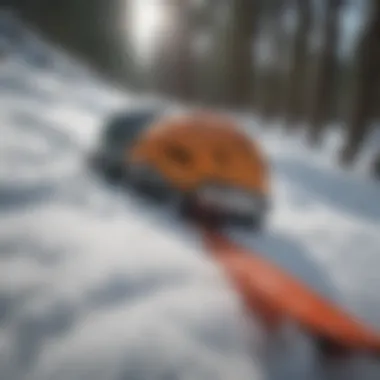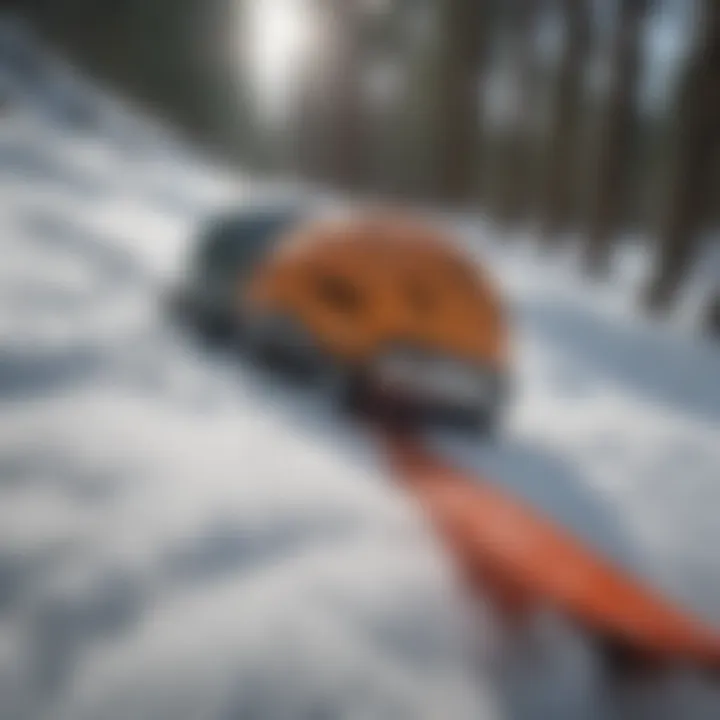Exploring Tobogganing in Snow-Covered Woodlands


Intro
Tobogganing, a thrilling winter activity, finds its roots in simple, traditional sledding methods. This pastime has not only evolved into a popular recreational sport but also serves as a gateway to connecting with nature, particularly in snow-covered woodlands. Understanding the intricate relationship between tobogganing, woodland ecosystems, and the essence of winter landscapes highlights the importance of preserving these environments.
This article will explore essential aspects of tobogganing in snowy woodland settings. We will look at the natural ecosystems that support this activity, delve into sustainable practices that can be adopted, and emphasize the significance of woodland stewardship. By doing so, we aim to underpin the role of tobogganing in fostering environmental awareness and appreciation for diverse ecosystems while promoting responsible outdoor activities.
Prolusion to Tobogganing
Tobogganing offers a unique blend of excitement and a connection to nature that deserves closer examination. This section is crucial as it lays the groundwork for understanding this winter activity. Exploring how tobogganing engages people with snow-covered woodlands can reveal insights into outdoor recreation, community interaction, and environmental awareness.
Definition and Overview
Tobogganing is a downhill slide on a small sled or toboggan, typically down snow-covered hills. The sled is usually made of a lightweight, flexible material that allows it to glide smoothly over snow. This activity has gained popularity in various regions, especially where winters blanket landscapes in snow. It is not just a pastime; tobogganing promotes social interaction among friends and families while fostering an appreciation for winter environments.
The beauty of tobogganing lies in its simplicity. Users of all ages can partake, making it an inclusive activity. In addition, tobogganing can be a gateway to more intensive winter sports, such as skiing or snowboarding, for those who seek a broader engagement with winter activities.
Historical Context
The origins of tobogganing can be traced back to Indigenous Peoples in North America. They devised the first models based on their needs for travel. These early toboggans were more than just recreational devices; they served as crucial tools for transport across snow-covered terrain.
The activity evolved significantly over the centuries. By the late 19th century, tobogganing became popular among settlers and tourists in areas rich in snow coverage. Ski resorts began incorporating toboggan runs as part of their offerings, creating a formalized experience for enthusiasts. This shift marked the transition from a purely functional activity to one enjoyed for leisure and sport.
The current landscape of tobogganing reflects both traditional practices and modern innovations. Today’s equipment is engineered for safety and speed, allowing a more thrilling experience. Woodlands, with their tranquil and picturesque environments, serve as perfect backdrops for tobogganing activities, promoting sustainable engagement with nature.
The Mechanics of Tobogganing
Understanding the mechanics of tobogganing is crucial for both novice and experienced enthusiasts. This knowledge enhances safety and elevates the overall experience. The design of the toboggan, the choice of materials, and proper fastening procedures greatly influence performance and security.
Toboggan Design and Material
The design of a toboggan significantly affects its functionality. Traditional toboggans are typically made from wood, which provides durability and a classic aesthetic. However, modern versions often incorporate plastics and composites to enhance performance. These materials can reduce weight while increasing speed on snowy slopes.
When choosing a toboggan, consider the following factors:
- Size: Toboggans come in various dimensions, impacting their stability and speed.
- Shape: A wider base offers more stability, while a narrower design can facilitate quicker movement downhill.
- Material: Plastic models are generally lighter and easier to maneuver, while wooden ones may provide a sturdier experience.
Balancing your personal preference with the design elements will contribute to an enjoyable and safe ride.
How to Fasten Your Toboggan for Optimal Safety
Ensuring that your toboggan is securely fastened is essential for maintaining safety during use. A loose toboggan may shift while in motion, increasing the risk of accidents. When preparing to descend, check the following:
- Straps and Clips: Ensure that all straps are tightened and clips are secured properly. Look for any signs of wear that might compromise functionality.
- Load Distribution: Distribute weight evenly on the toboggan. This balance affects stability, helping reduce the chance of tipping as you navigate turns.
- Personal Equipment: Secure any gear or equipment that you might carry while tobogganing. Loose items can shift and become dangerous during rapid movement.
Taking time to fasten your toboggan correctly not only promotes safety but also enhances the overall experience.
“A well-fitted toboggan can mean the difference between a thrilling ride and an unsafe experience.”
Tobogganing Techniques
Understanding tobogganing techniques is crucial for anyone looking to enjoy this winter pastime safely and effectively. Proper techniques can significantly enhance the overall experience while ensuring safety in the often unpredictable snowy environment. A solid grasp of the essentials can lead to more enjoyable runs and a deeper appreciation for the natural surroundings. The joy of tobogganing lies not only in the thrill but also in mastering the skills needed for a successful descent.
Starting Your Journey
The initial phase of tobogganing is fun yet requires attention. Before beginning, familiarize yourself with the toboggan you will use. Check the sled for any damage that could affect performance. When you are ready to start, find a suitable slope that is not too steep. Make sure it is clear of obstacles and has a soft, smooth landing.
Position yourself properly on the toboggan; lying flat with your feet slightly raised can give you better control. It’s important to push off with a little force to gain momentum initially. This strategy can set you on a smooth path down the hill without needing to compensate with excessive steering later.
Also, consider using an incline that is well-packaged for beginners. Many local parks provide groomed toboggan runs, which can be an excellent choice for those just starting.


Controlling Momentum and Steering
As you descend, controlling your momentum is essential. Utilizing your body weight can help maintain balance and direct the toboggan. Leaning into turns enables sharper steering, helping to keep your path on track. Be aware of your speed; excessive momentum can lead to loss of control, causing potential accidents.
To keep your steering precise, use gentle, calculated movements. Abrupt shifts can lead to skidding or tipping. Moreover, practice observing the terrain ahead. This foresight provides insights into necessary adjustments and helps anticipate potential challenges. Always adapt your body position based on the slope and conditions. A well-managed descent leads to enjoyable runs and ensures a return to the top in one piece.
Braking Methods and Techniques
Mastering braking methods is a vital part of tobogganing. Understanding when and how to slow down can prevent mishaps and enhance safety. The two primary techniques are friction and drag.
Using your feet to create friction is the simplest way to slow down. Place them firmly against the snow, but be cautious. This method works well for moderate speeds but may not be effective if you are approaching excessive velocities.
Alternatively, for more effective braking, try to drag your hands in the snow. This technique distributes the force more evenly and allows for greater control, especially on steeper descents. Remember that these methods take practice. The key is to anticipate your stopping point and practice braking gradually, especially as you become familiar with various terrains and conditions.
"Safety is not just a seatbelt; it’s knowledge, awareness, and practice in every venture outdoors."
Utilizing these techniques will not only improve your tobogganing skills but will ensure you have a secure and enjoyable experience in the snow-covered woodlands.
Safety Considerations
Safety is a paramount factor in any winter sport, and tobogganing is no exception. Understanding potential hazards and implementing effective safety measures can significantly enhance the enjoyment of this activity while minimizing risks. The importance of focusing on safety considerations cannot be overstated. Proper attention to safety not only protects individuals but also fosters a culture of responsible outdoor recreation. This leads to a more enjoyable experience for everyone involved.
Choosing Safe Locations
Selecting the right location for tobogganing is crucial. Not all areas are suitable for this activity, and understanding the terrain is essential. Ideal spots should be free from obstacles such as rocks, trees, or fences. It is wise to opt for hills with a gentle gradient, as they provide a safer and more predictable sliding experience.
When selecting a tobogganing site, consider the following:
- Visibility: Ensure that the area is clear and visible, allowing you to see any potential hazards ahead.
- Slope: Choose a slope that has a moderate incline to keep speeds manageable.
- Crowd Size: Avoid locations that are overly crowded, as this increases the risk of collisions.
To help identify safe locations, local clubs or organizations may offer lists or maps of recommended hills. Researching these resources can help to make informed choices.
Assessing Weather and Snow Conditions
Weather plays a significant role in safety during tobogganing. Snow conditions can affect how smoothly a toboggan will slide and how easily the rider controls it. When planning your outing, check local forecasts and consider the following:
- Temperature: Extreme cold can lead to frostbite, while milder conditions may result in slushy snow, impacting speed and control.
- Fresh Snow: Recent snowfall can improve the riding experience. However, it may also hide obstacles beneath the surface.
- Ice Formation: Assess for any icy patches on the hill. Ice can significantly increase speeds and reduce braking ability, leading to potential accidents.
By constantly monitoring weather patterns and snow conditions, riders can better anticipate changes that may affect safety.
Personal Protective Equipment Recommendations
Using personal protective equipment is an essential aspect of ensuring safety while tobogganing. While the nature of tobogganing may make it seem like a simple activity, the potential for injury exists. Therefore, wearing the right gear can prevent injuries or lessen their severity. Recommended equipment includes:
- Helmet: Protects the head from impact during falls.
- Knee and Elbow Pads: Provide cushioning against hard surfaces.
- Waterproof and Insulated Clothing: Keeps riders warm and dry, reducing the risk of hypothermia.
Investing in quality personal protective equipment is a wise decision, offering peace of mind and allowing for a more enjoyable experience on the slopes.
Riding safely also involves awareness and understanding of your surroundings. Always be alert and consider fellow enthusiasts who share the space.
Environmental Impact of Tobogganing
The environmental impact of tobogganing is a multifaceted topic that highlights both the enjoyment of winter recreation and the need for ecosystem conservation. This section aims to elaborate on how tobogganing affects woodland ecosystems. It addresses the benefits and the necessary considerations when engaging in this activity.
Tobogganing provides substantial recreational benefits, promoting physical health and connecting people with nature. However, it is crucial to acknowledge the risk of disturbing local ecosystems. As outdoor enthusiasts ride down snow-covered slopes, their activities can lead to soil compaction, vegetation damage, and even wildlife disruption. Understanding these impacts is essential for both enjoyment and preservation of our natural environments.
Ecosystem Disturbance
One of the primary concerns with tobogganing in woodlands is the potential for ecosystem disturbance. When participants choose to ride down hills, they may inadvertently impact soil composition and plant life. Compacted snow can lead to a lack of insulation for the ground underneath, disrupting the natural freeze-thaw cycle that many plants depend on during the winter months. Additionally, disturbing snow cover can expose delicate plants to harsher conditions, affecting their growth.
Wildlife also feels the effects of tobogganing activities. Animals may alter their habits in response to human presence, which can lead to nesting disruptions or changes in feeding patterns. Understanding local wildlife habitats is crucial. Riders should avoid areas known for critical wildlife activities, especially during winter months when animals are already stressed due to food shortages.


It’s important to remind tobogganers to respect designated trails and stay on established routes to minimize their ecological footprint. In doing so, recreation can be enjoyed without overly disrupting the habitats that make winter woodlands a balanced ecosystem.
Conservation Practices for Winter Recreation
Adopting conservation practices is vital to ensure tobogganing remains a sustainable activity. Awareness and education can significantly mitigate negative impacts on the environment. Here are several critical practices that can be observed:
- Leave No Trace Principles: These principles encourage individuals to take what they bring in. This includes ensuring that litter is picked up and no natural materials are removed from the environment.
- Use Designated Areas: Tobogganers should stick to existing toboggan trails or designated slopes to prevent unwanted disruptions to untouched areas.
- Seasonal Awareness: Understanding the timing of wildlife activity in specific woodlands can help inform users about appropriate times for tobogganing to avoid disturbance during critical periods.
- Educate Fellow Enthusiasts: Encourage other tobogganers to be mindful of ecological impacts. Sharing knowledge about local ecosystems fosters a culture of respect and responsibility.
By practicing these principles, winter recreation can flourish alongside conservation efforts. It ensures that generations to come can also enjoy these beautiful winter landscapes that call for exploration.
In summary, understanding the environmental impact of tobogganing enriches the experience, making it not only enjoyable but also more responsible. Embracing sustainable practices helps preserve woodland ecosystems while still enjoying the thrill of the ride.
Winter Safety for Woodlands Enthusiasts
Winter tobogganing, while exhilarating, requires careful consideration of safety to prevent accidents and ensure a fulfilling experience. This section highlights key elements of winter safety that enthusiasts should prioritize during their time in snow-covered woodlands. The diverse and often unpredictable winter environments pose unique challenges, making safety preparations essential.
Navigating Snowy Trails
When navigating snowy trails, familiarity with the area is crucial. Woodlands can offer both pleasing scenery and hidden dangers. Here are some significant points to consider:
- Plan Your Route: Before embarking on your tobogganing adventure, review maps and familiarize yourself with the layout of the trails. Consider choosing well-known routes which are marked for winter sports.
- Stay on Designated Paths: Straying from marked trails can lead to accidents as unfamiliar territories often hide hazards like steep drops, hidden rocks, or patchy ice.
- Evaluate Conditions: Assess the snow conditions before you head out. Heavy snowfall can obscure more treacherous areas, while melting or icy patches may create hazardous spots. Being vigilant about changing conditions increases safety.
"Preparation and awareness are the first steps in ensuring safety while enjoying winter activities in the woods."
Understanding Wildlife Habitats During Winter
Understanding wildlife in winter is equally important. Many species adapt to the cold and may be more visible in snow-covered landscapes. Here are key considerations:
- Avoid Disturbing Wildlife: Animals can be more vulnerable during the winter months. Disturbing their habitats may cause unnecessary stress or disrupt their natural behavior. Observe wildlife from a distance without encroaching on their space.
- Identify Animal Tracks: Learning to recognize animal tracks in the snow not only enhances appreciation for nature but also helps to avoid surprising wildlife. This knowledge creates respect for their territory and behavior.
- Respect Seasonal Habitats: Some areas may be designated as critical habitats for specific species during winter. Awareness of these areas can guide enthusiasts to routes that minimize their impact on wildlife, promoting an overall balanced environment for both recreation and nature.
Tobogganing in Different Types of Woodlands
Tobogganing provides a unique opportunity to connect with the natural environment. The type of woodland influences the experience of tobogganing in many ways. Each woodland type presents distinct features that affect the snow conditions, landscape, and overall enjoyment of the sport. Understanding these distinctions aids in selecting suitable locations for recreational activities while appreciating the intricate ecosystems at play.
Deciduous Forests
Deciduous forests, characterized by trees that shed their leaves annually, create a visually stunning backdrop for tobogganing. During winter, the bare trees allow sunlight to penetrate, illuminating the snow-covered ground. This can create a magical environment for enthusiasts.
When tobogganing in deciduous forests, consider the following points:
- Variety of Terrain: The undulating hilly nature often found in deciduous areas offers diverse slopes that can challenge both beginners and advanced tobogganers alike.
- Trail Conditions: Snow accumulation can vary due to the exposure of the terrain. Areas with more sunlight may have crusted snow, whereas shaded spots might retain softer powder, impacting control and speed.
- Wildlife Awareness: During winter, many animals hibernate or become less active. However, awareness of potential wildlife habitats is important as tobogganing could disturb these areas.
Coniferous Forests
Coniferous forests, dominated by pine and spruce trees, offer distinct advantages for tobogganing. The evergreen canopy retains snow better than deciduous trees. The consistent coverage can lead to excellent snow conditions for sliding down slopes.
Essential considerations for tobogganing in coniferous forests include:
- Stable Snow Conditions: The thick canopy of coniferous trees helps maintain a thicker layer of powder snow, ensuring smoother rides and fewer exposed obstacles.
- Pitch and Run: These forests often have steeper areas, which can lead to exhilarating runs but require careful navigation. The incline can lead to higher speeds, thus reinforcing the need for safety gear.
- Limited Light: The dense tree cover can result in reduced lighting. Tobogganers should plan outings when there is adequate daylight to avoid hazards that might be obscured by shadows.
Mixed Woodlands
Mixed woodlands, which host a combination of both deciduous and coniferous species, provide a rich setting for tobogganing enthusiasts. The intermingling of trees results in varied landscapes that can enhance the experience.
Key features to consider when tobogganing in mixed woodlands include:
- Diverse Environment: The mix of tree types influences snow retention and trail conditions. This variety allows for different experiences on each run.
- Ecosystem Balancing: Mixed woodlands support a broader range of wildlife. Understanding this aspect is important. Tobogganing should be done in a manner that respects the habitats present.
- Variable Terrain: The uneven ground often creates unique trails for tobogganing. Some areas may be fast and steep, while others might facilitate gentle slopes.
"Tobogganing in varying woodlands illustrates the balance between recreation and nature's integrity, capturing the essence of winter enjoyment while fostering appreciation for the environment."
The Role of Community in Enhancing Tobogganing Experiences


Engagement in tobogganing often extends beyond individual enjoyment. A strong community surrounding this activity can cultivate shared experiences that elevate the enjoyment of tobogganing. This communal aspect not only fosters friendships but also encourages a deeper connection to the local environment. When individuals participate together, there is an increase in safety awareness and knowledge sharing that benefits everyone involved. Moreover, community-centric tobogganing encourages stewardship of our woodlands, leading to more responsible recreation practices.
Local Toboggan Clubs and Organizations
Local toboggan clubs and organizations act as hubs for enthusiasts. These groups typically offer a platform for organizing outings, sharing information on safe practices, and maintaining tobogganing trails. Members provide valuable insights into optimal locations for tobogganing and varying techniques. Moreover, through club gatherings, newcomers can learn directly from seasoned tobogganers.
Membership in these clubs often comes with several benefits, including:
- Resource Sharing: Members can exchange equipment or even toboggans, making the sport accessible to many.
- Skill Development: Clubs usually offer clinics or workshops to improve tobogganing skills and safety.
- Advocacy and Fundraising: Many clubs engage in advocacy efforts, ensuring that tobogganing locations remain open. They often organize fundraising events to maintain the trails or improve facilities.
By connecting individuals, local clubs create a sense of belonging, making it easier for people to participate in this winter activity.
Collaborative Events and Programs
Collaborative events provide opportunities for greater participation and community involvement. These events can range from informal meetups to larger competitions that involve various clubs and organizations.
Such programs might include:
- Tobogganing Festivals: Celebrating the sport and encouraging families to participate. These festivals usually include races, timed events, and contests.
- Community Clean-Up Days: Engaging participants in maintaining the quality of tobogganing areas. These activities foster environmental stewardship.
- Youth Programs: Specifically developed for younger participants to learn safe tobogganing techniques in a fun environment.
Overall, collaborative events deepen the ties among members and promote stewardship of the woodland areas used for tobogganing. They not only build skills but also values such as teamwork and respect for nature.
By enhancing community collaboration in tobogganing, individuals can promote a culture of safety, fun, and environmental responsibility that benefits everyone involved.
Promoting Sustainable Tobogganing Practices
Tobogganing is an exhilarating winter activity that many people enjoy, often within lush, snow-covered woodlands. However, as enthusiasts engage in this pastime, the significance of sustainable practices cannot be overlooked. Promoting sustainable tobogganing is crucial for ensuring that natural environments are protected and remain available for future generations.
When considering the impact of tobogganing on woodlands, several factors come into play. Each time a toboggan glides over snow, it can potentially disturb delicate ecosystems below. Sustainable methods help mitigate these disturbances. Concerns include the trampled flora and habitat destruction. Thus, a conscious effort must be employed by riders to minimize ecological footprints.
Embracing sustainable tobogganing not only preserves natural beauty but also fosters a deeper appreciation for the landscape. This heightened awareness encourages individuals to take responsibility for their actions during recreational activities.
Leave No Trace Principles
The Leave No Trace principles are paramount to maintaining the integrity of woodland ecosystems. These guidelines help participants understand the importance of preserving their surroundings.
- Plan Ahead and Prepare: Gather necessary supplies and check specific site regulations.
- Travel and Camp on Durable Surfaces: Stick to established trails to reduce soil erosion and protect vegetation.
- Dispose of Waste Properly: Always bring back trash and waste, ensuring a clean environment.
- Leave What You Find: Avoid taking natural items, such as rocks or plants, which can harm local biodiversity.
- Minimize Campfire Impact: If fires are permitted, use designated areas and follow local guidelines.
- Respect Wildlife: Observe animals from a distance, ensuring human interaction does not disrupt their natural behaviors.
- Be Considerate of Other Visitors: Keep noise levels down and respect diverse enjoyment preferences in shared spaces.
Adhering to these principles fosters a culture of respect within the community. This shared responsibility ultimately enhances the outdoor experience while protecting the stunning woodlands we cherish.
Educating Others about Responsible Recreation
Education plays a critical role in promoting responsible tobogganing practices. Engaging the community is essential to highlight the significance of sustainable habits. Here are some effective methods:
- Workshops and Seminars: Providing educational outreach about sustainable tobogganing can inform individuals about the ecology of the areas they enjoy.
- Social Media Campaigns: Utilizing platforms like Facebook and Reddit can raise awareness and share tips on responsible practices.
- Collaborating with Local Organizations: Toboggan clubs can partner with environmental groups to host events centered on sustainable recreation.
- Creating Informational Materials: Distributing flyers, brochures, or digital content can serve as reminders of the best practices for preserving our cherished landscapes.
By actively participating in educational initiatives, toboggan enthusiasts can transform the landscape of winter recreation into one that values and preserves nature.
"Protecting our woods is not just a responsibility; it’s an opportunity to enrich the experience of tobogganing for everyone."
Culmination
Tobogganing presents an engaging intersection between recreation and the appreciation of our natural environments. The unique appeal of this winter sport lies not just in the thrill of the descent, but also in its capacity to foster connections with the landscapes we navigate. Participants find joy in the act, yet the deeper significance is often overlooked.
Reflection on Tobogganing’s Unique Appeal
The thrill of tobogganing is palpable. As one glides down snowy slopes, the rush of wind and the cold bite of air invigorate the senses. However, this experience transcends mere excitement. Tobogganing encourages an immersive engagement with the woodlands, promoting an awareness of ecological balances and seasonal changes. The distinct landscape of snow-covered trees and winter wildlife provides a picturesque backdrop that enhances the adventure.
Moreover, tobogganing is accessible to many, requiring little equipment and facilitating participation across various age groups. This inclusivity can foster a sense of community, as families and friends come together, sharing the experience and creating lasting memories. The laughter and exhilaration often echo through the forests, linking participants not only to each other but also to the environment around them.
Future of Tobogganing in Urban and Natural Environments
Looking forward, tobogganing faces both challenges and opportunities in urban and natural settings. Urban areas can strategically develop designated tobogganing spots, integrating them into city parks while ensuring safety and minimizing environmental impact. Such developments could offer city dwellers a taste of winter recreation without requiring extensive travel into remote areas.
In natural environments, it is crucial to promote sustainable practices that protect the ecosystems where tobogganing occurs. Community involvement in maintaining these areas can lead to better conservation efforts, ensuring that future generations can enjoy similar experiences. By advocating for responsible use of woodlands, we can support both recreational enjoyment and ecological integrity.
Ultimately, the future of tobogganing lies in our ability to balance enjoyment with responsibility. Through informed practices and community engagement, tobogganing can evolve, remaining a significant winter activity that fosters respect for the natural world.







